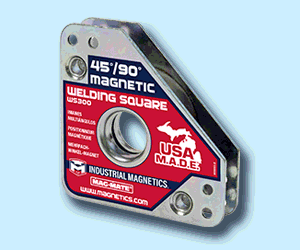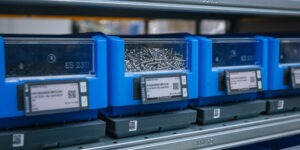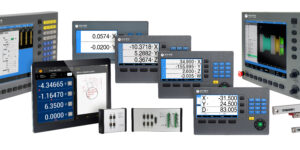IN THE LOOP: MODERN DAY MOTHER OF INVENTION
Now, more than ever before, coupling advanced technology with welding processes is necessary to work faster, work smarter, and remain competitive. Mike Riley shows why.
Posted: February 9, 2009
"Necessity is the mother of invention" is a saying as old as humanity, but it's just as applicable in these trying times today as when it was first uttered.
Think about it. As Corporate Average Fuel Economy (CAFE) requirements in the automotive industry continue to rise, welding aluminum is a necessity that is increasing in importance, especially as the welding workforce of skilled operators and welding engineers is diminishing. Aerospace and medical are other industries that benefit from the precise welds only a robot, as a necessity, can consistently perform.
For these reasons, most welding experts agree that coupling advanced technology with arc welding processes is the "mother of invention" necessary to remain competitive. "Intense competition and more stringent quality standards generate pressure to work faster, smarter and more efficiently," says Geoff Lipnevicius, the engineering manager of the Automation Division for Lincoln Electric (Cleveland, OH).
This is why Lincoln Electric partnered with FANUC Robotics America Inc. (Rochester Hills, MI) to create the ARC Mate 100iC/Power Wave® i400, an automated arc-welding platform that addresses growing safety, environmental and economic concerns with high-speed welding performance for lighter, stronger components using high-strength and/or challenging coated materials. It also eliminates processes and reduces the number of steps involved in creating parts.
The time and cost saved from eliminating processes and improving quality via robotic welding really add up when one adds the 3D vision of the built-in iRVision® ready-to-use robotic vision package. "Anything you?re going to weld or join together is usually a formed or fabricated part," explains Michael Sharpe, the director of engineering for materials joining/arc welding and laser for FANUC. "Formed or fabricated parts must be trimmed by either mechanical cutting (a trim die or laser) or some other pre-process operation before joining the parts. This is critical because the weld path must be on the actual joint of the metal interface."
"This system is unique because the integrated vision allows the robot to basically sense for variance to safely eliminate the pre-process operation. If a manufacturer once trimmed for a perfect fit, he may now eliminate trimming and still get good weld quality because the weld is on the correct location from part to part."
"As part of the whole intelligent robot system for arc welding, vision senses displacement in the part and the joint," notes Sharpe. "Creating the actual weld programs can either be taught using the control pendant or created off-line using proprietary software with an integrated cable design. Operating a robot system still requires operator expertise to understand what material is being joined, think through the setup, and decide what weld filler wire and gas to use."
To leverage this expertise with automation, the 100iC approaches arc welding from a fresh perspective. "This new, evolutionary design builds the robot around the process, rather than adapting the process to the robot," adds Sharpe. Compared to traditional dress packages mounted externally on the robot arm, the dress package in the 100iC internal routing follows the motion range of the robot, simplifying programming and eliminating any worries of bending, snagging or breaking cables.
This platform increases acceleration 15 percent for higher motion performance, a 10 kg payload (67 percent more than before) and a slimmer forearm. With the robot base reduced in size by 15 percent, reach is maximized in confined areas. Multiple robots can be installed in close proximity to save valuable floor space.
The platform pipeline communicates via ArcLink over Ethernet (ArcLink® XT). "We examined Ethernet vs. USB," says Lipnevicius. "Testing concluded that Ethernet was faster and more reliable." The intelligence in the system leads to even more autonomy. Once the weld path is created it can be stored in a repository like a PC and shared among other similar robots, processes or applications.
Every ARC Mate welding robot has a 50 mm through-hole for applications ranging from water-cooled torches to high-amperage torches, wire-brakes and sensors. The through-hole interface at the wrist is identical with the one at the wire feeder. The differences are in the reach, the stroke and the payload, which depend upon the wrist sizing. The AutoDrive? 4R90 wire feeder is a compact yet rugged package that maximizes robot acceleration performance and throughput.
But the necessity doesn?t stop there. With robotic welding's continued growth in popularity largely due to the critical shortage of skilled labor, these same two companies created the Robotic Education Cell, an instructional cell for educational institutions, training departments and other facilities to teach robotic programming related to gas metal arc welding (GMAW).
This cell gives students a foundation in robotic welding basics and more sophisticated technologies to prepare them for industries ranging from building and construction to shipbuilding, manufacturing and oil field services.
"The future of welding lies in motivating students to learn the trade and the newest technologies," states Lipnevicius. "This cell incorporates robotics into welding education programs, providing real-world knowledge that easily integrates on the job ? not only in manufacturing, but other welding-intensive industries as well."
The small, lightweight Robotic Education Cell is 81 in tall x 27 in wide x 65 in long, to fit through a standard doorway. The cell is ready to go out of the box and moves easily on casters between classrooms for demonstrations. Packages include integrated gas bottle rack/storage, fume extraction mounting, integrated safety measures and numerous FANUC software options. The cell uses a single power drop to connect the ARC Mate 50iC/5L, Power Wave® 355M welding power source and AutoDrive? 4R90 wire feeder welding package.
Another necessity that deals with long welds and stressful welding positions for the welder is the Miggytrac automated tractor from ESAB Welding & Cutting Products (Florence, SC). This small, compact motorized tractor attaches quickly to welding torches and provides even, stable movement for superior welding performance and significant increases in welding speed, particularly when using cored wire.
The 1001 tractor uses a remote control for start/stop, travel direction indication, wire feed speed and voltage, with travel speed settings of 6 to 47 ipm (150 to 1200 mm/min). A magnet on the 2000 tractor holds it in the correct position on the workpiece, even when bent or angled. Adjustable guide wheels allow the tractor to drive itself against the workpiece.
The 2000 model can be programmed for intermittent welding, with a backfill function for crater filling at the end of the weld. This tractor handles length of weld and distance between welds from 0.4 to 39 in (1-99 cm). High speed travel between welds reaches 98 ipm (250 cm/min) to increase efficiency.
The 3000 tractor uses an integrated wire feed and water-cooled welding torch for horizontal mechanized MIG welding of plates and beams. The four-wheel drive carriage can travel diagonally towards the flange or stiffener being welded. This tractor can also be programmed for intermittent welding, with separate control for the carriage motion and wire feed. The wire feed speed, time for gas pre-flow, gas post-flow and burnback are also programmable. The 3000 model handles length of weld and distance between welds from 0.4 to 39 inch (1-99 cm). High speed travel between welds reaches 98 ipm (250 cm/min) for optimal efficiency.
A necessity for welders who stick weld and want to use flux cored wire is the MultiMaster® 300X multipurpose welder from ESAB, a ready-to-weld package for MIG, DC TIG and stick electrode welding with Dual Shield X flux cored wire. Dual Shield X wires forgive much more than traditional flux cored wires, especially for less experienced welders. They give the welder a wider range of operating parameters, high deposition rates, fast travel speeds, flat bead profile, limited spatter and extremely easy slag removal.
The proprietary Super Switch? technology on the 300X makes welding with Dual Shield wire exceptionally easy, with DC welding output from 15 to 300 amps at 40 percent duty cycle using a high-speed solid-state power control that produces arc performance comparable to considerably more complex and expensive power sources. An output pre-set control with two digital meters allows quick set up straight from a Dual Shield X series quick set-up card.
This system includes a fan on demand, a heavy-duty four-drive roll stand with serrated Dual Shield X Series wires in .045 in and .052 in dia, a 400-amp, 15 ft gun set up for the same diameters, a convenient, large-capacity tool box, and an "easy-on" cylinder tray. The package includes power source, built-in four-roll wire feeder, factory-installed undercarriage and cylinder rack, torch, contact tips, regulator/flowmeter, electrode holder and plug, and all necessary hoses and cables to make the machine ready to use right out of the box.
When rescue teams are called into action to extricate accident casualties and save lives, every second counts. For them, the Arcair SLICE Pack cutting system from Thermadyne Industries (St. Louis, MO) is an absolute necessity. Unlike any other cutting process, this exothermic cutting system can burn, cut or pierce virtually any metallic, non-metallic or composite material quickly and safely.
In a construction accident or collapsed building, the torch can pierce concrete and cut through rebar and structural steel. If structural failure occurs due to natural disasters or a heavy equipment accident, it can free victims by burning through nearly any metallic or non-metallic material three times faster than any oxyacetylene torch on 3 in mild steel.
This cutting system is ideal
for quick entry and extraction in a wide variety of rescue situations, allowing rescuers to cut through locks, deadbolts, steel doors, floors, roofs, frame walls, iron bars, gratings, metal roofing, brick, concrete and virtually any other obstacle.
This torch requires no pre-heating for rescuers who must act quickly, feeding oxygen and electrical power for ignition to a patented magnesium cutting rod. The rod ignites immediately after turning on the oxygen and touching the cutting rod to the striker. Once the exothermic reaction begins, continuing electrical power is not needed because the cutting rod continues to burn as long as the oxygen flow continues. The exothermic principle enables the operator to keep a fog nozzle spraying right on the cutting area during the cut.
This system is safer than many other cutting methods because it doesn?t require electrical power or special fuel gasses while cutting. And because the torch cuts so fast, head conductivity and build-up remain at a minimum. Realizing that emergency workers must squeeze into tight spaces with operating flexibility, the equipment is portable and self-contained. Because the torch runs on oxygen and has a built-in re-chargeable battery, the system can go anywhere.
For automobile assembly lines, an immediate necessity to lower costs, operation and maintenance is the Servo-Spot Reduction Gear X-Type Gun from Dengensha America (Beford, OH). Using the same reduction gear technology employed for robot actuation generates higher force with less energy and makes this gun highly accurate. Alignment accuracy and pressure consistency are increased, improving weld quality and reducing warping, indentations and spatter.
Constructed in a symmetrical design with no right or left hand "reduces inventory of spare guns and spare parts," explains sales representative Tom Zambelli of Dengensha. "This design also eliminates hinges to prevent tip misalignment caused by a worn out hinge, and increases the drive unit life by being dust- and water-resistant. The reduction gear drive really is maintenance free."
– – – – – – – – – – – – – – – – – – – – – – – – – – – – – – – – – – – – – – – – –
Mike Riley is the editor of Fabricating & Metalworking magazine and the author of Backfield in Motion (Derek Press, 2007). Contact him at 205-681-3393 or [email protected].
The Lincoln Electric Company, 22801 St. Clair Avenue, Cleveland, OH 44117, 216-481-8100, Fax: 216-486-1751, www.lincolnelectric.com.
Fanuc Robotics America Inc., 3900 W. Hamlin Road, Rochester Hills, MI 48309, 248-377-7000, www.fanucrobotics.com.
ESAB Welding & Cutting Products, 411 South Ebenezer Road, Florence, SC 29501, 843-669-4411, www.esab.com.
Thermadyne Industries, 16052 Swingley Ridge, #300, St. Louis, MO 63017, 636-728-3000, Fax: 636-728-3021, www.tweco.com.
Dengensha America Corporation, 7647 First Place, Cleveland, OH 44146, 440-439-8081, www.dengensha.com.
















